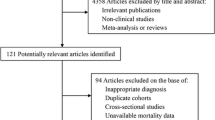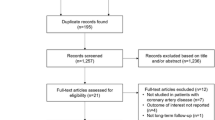Abstract
Purpose
Obstructive sleep apnea (OSA) is associated with the management of atrial fibrillation (AF). This manuscript aims to discuss the effects of continuous positive airway pressure (CPAP) in patients with rhythm control strategies and patients with different ages, weights and length of follow-up.
Methods
We searched Embase, PubMed, Cochrane, Web of Science and Ovid for relevant studies (from inception to 7 July 2019; English). The primary outcome was documented AF recurrence in CPAP users and nonusers. We assessed pooled data by use of a random-effects model.
Results
Nine prospective cohort studies with a total of 2134 participants met the inclusion criteria. Results showed that complementary CPAP therapy reduced AF recurrence (RR = 0.63; 95% CI, 0.56–0.72). In subgroup analyses, the benefits of CPAP were stronger in patients younger than 60 years old (< 60 years old: RR, 0.59; 95% CI, 0.50–0.68 vs. ≥ 60 years old: RR, 0.73; 95% CI, 0.59–0.91), with a body mass index (BMI) of less than 30 (< 30: RR, 0.53; 95% CI, 0.37–0.77 vs. ≥ 30: RR, 0.65; 95% CI, 0.55–0.77) or with less follow-up time (≤ 1 year: RR, 0.57; 95% CI, 0.42–0.79 vs. > 1 year: RR, 0.64; 95% CI, 0.53–0.78).
Conclusions
Complementary CPAP therapy reduces the risk of AF recurrence in OSA patients with rhythm control strategies. In addition to weight control and early AF intervention, CPAP compliance should be recommended along with periodic adjustments as necessary.


Similar content being viewed by others
References
Young T, Palta M, Dempsey J, Skatrud J, Weber S, Badr S. The occurrence of sleep-disordered breathing among middle-aged adults. N Engl J Med. 1993;328(17):1230–5. https://doi.org/10.1056/nejm199304293281704.
Lavie P, Ben-Yosef R, Rubin AE. Prevalence of sleep apnea syndrome among patients with essential hypertension. Am Heart J. 1984;108(2):373–6. https://doi.org/10.1016/0002-8703(84)90628-8.
Gami AS, Pressman G, Caples SM, Kanagala R, Gard JJ, Davison DE, et al. Association of atrial fibrillation and obstructive sleep apnea. Circulation. 2004;110(4):364–7. https://doi.org/10.1161/01.cir.0000136587.68725.8e.
Mehra R, Benjamin EJ, Shahar E, Gottlieb DJ, Nawabit R, Kirchner HL, et al. Association of nocturnal arrhythmias with sleep-disordered breathing: the Sleep Heart Health Study. Am J Respir Crit Care Med. 2006;173(8):910–6. https://doi.org/10.1164/rccm.200509-1442OC.
Miyasaka Y, Barnes ME, Gersh BJ, Cha SS, Bailey KR, Abhayaratna WP, et al. Secular trends in incidence of atrial fibrillation in Olmsted County, Minnesota, 1980 to 2000, and implications on the projections for future prevalence. Circulation. 2006;114(2):119–25. https://doi.org/10.1161/CIRCULATIONAHA.105.595140.
Gottlieb DJ, Yenokyan G, Newman AB, O’Connor GT, Punjabi NM, Quan SF, et al. Prospective study of obstructive sleep apnea and incident coronary heart disease and heart failure: the sleep heart health study. Circulation. 2010;122(4):352–60. https://doi.org/10.1161/circulationaha.109.901801.
Lavie L. Oxidative stress in obstructive sleep apnea and intermittent hypoxia--revisited--the bad ugly and good: implications to the heart and brain. Sleep Med Rev. 2015;20:27–45. https://doi.org/10.1016/j.smrv.2014.07.003.
Zhao YY, Wang R, Gleason KJ, Lewis EF, Quan SF, Toth CM, et al. Effect of continuous positive airway pressure treatment on health-related quality of life and sleepiness in high cardiovascular risk individuals with sleep apnea: Best Apnea Interventions for Research (BestAIR) Trial. Sleep. 2017;40(4). https://doi.org/10.1093/sleep/zsx040.
Nishihata Y, Takata Y, Usui Y, Kato K, Yamaguchi T, Shiina K, et al. Continuous positive airway pressure treatment improves cardiovascular outcomes in elderly patients with cardiovascular disease and obstructive sleep apnea. Heart Vessel. 2015;30(1):61–9. https://doi.org/10.1007/s00380-013-0451-x.
Yancy CW, Jessup M, Bozkurt B, Butler J, Casey DE Jr, Colvin MM, et al. 2017 ACC/AHA/HFSA focused update of the 2013 ACCF/AHA guideline for the management of heart failure: a report of the American College of Cardiology/American Heart Association Task Force on Clinical Practice Guidelines and the Heart Failure Society of America. J Am Coll Cardiol. 2017;70(6):776–803. https://doi.org/10.1016/j.jacc.2017.04.025.
Linz D, McEvoy RD, Cowie MR, et al. Associations of obstructive sleep apnea with atrial fibrillation and continuous positive airway pressure treatment: a review. JAMA Cardiol. 2018;3(6):532–40. https://doi.org/10.1001/jamacardio.2018.0095.
McEvoy DRMD, Antic NAMDPD, Heeley EPD, et al. CPAP for prevention of cardiovascular events in obstructive sleep apnea. N Engl J Med. 2016;375(10):919–31. https://doi.org/10.1056/NEJMoa1606599.
Craig S, Pepperell JCT, Kohler M, Crosthwaite N, Davies RJO, Stradling JR. Continuous positive airway pressure treatment for obstructive sleep apnoea reduces resting heart rate but does not affect dysrhythmias: a randomised controlled trial. J Sleep Res. 2009;18(3):329–36. https://doi.org/10.1111/j.1365-2869.2008.00726.x.
Kanagala R, Murali NS, Friedman PA, Ammash NM, Gersh BJ, Ballman KV, et al. Obstructive sleep apnea and the recurrence of atrial fibrillation. Circulation. 2003;107(20):2589–94. https://doi.org/10.1161/01.CIR.0000068337.25994.21.
Jongnarangsin K, Chugh A, Good E, et al. Body mass index, obstructive sleep apnea, and outcomes of catheter ablation of atrial fibrillation. J Cardiovasc Electrophysiol. 2008;19(7):668–72. https://doi.org/10.1111/j.1540-8167.2008.01118.x.
Patel D, Mohanty P, Di Biase L, et al. Safety and efficacy of pulmonary vein antral isolation in patients with obstructive sleep apnea: the impact of continuous positive airway pressure. Circ Arrhythm Electrophysiol. 2010;3(5):445–51. https://doi.org/10.1161/circep.109.858381.
Bazan V, Grau N, Valles E, Felez M, Sanjuas C, Cainzos-Achirica M, et al. Obstructive sleep apnea in patients with typical atrial flutter: prevalence and impact on arrhythmia control outcome. Chest. 2013;143(5):1277–83. https://doi.org/10.1378/chest.12-0697.
Fein AS, Shvilkin A, Shah D, Haffajee CI, Das S, Kumar K, et al. Treatment of obstructive sleep apnea reduces the risk of atrial fibrillation recurrence after catheter ablation. J Am Coll Cardiol. 2013;62(4):300–5. https://doi.org/10.1016/j.jacc.2013.03.052.
Naruse Y, Tada H, Satoh M, Yanagihara M, Tsuneoka H, Hirata Y, et al. Concomitant obstructive sleep apnea increases the recurrence of atrial fibrillation following radiofrequency catheter ablation of atrial fibrillation: clinical impact of continuous positive airway pressure therapy. Heart Rhythm. 2013;10(3):331–7. https://doi.org/10.1016/j.hrthm.2012.11.015.
Neilan TG, Farhad H, Dodson JA, Shah RV, Abbasi SA, Bakker JP, et al. Effect of sleep apnea and continuous positive airway pressure on cardiac structure and recurrence of atrial fibrillation. J Am Heart Assoc. 2013;2(6):e000421. https://doi.org/10.1161/jaha.113.000421.
Holmqvist F, Guan N, Zhu Z, et al. Impact of obstructive sleep apnea and continuous positive airway pressure therapy on outcomes in patients with atrial fibrillation - results from the Outcomes Registry for Better Informed Treatment of Atrial Fibrillation (ORBIT-AF). Am Heart J. 2015;169(5):647–54.e642. https://doi.org/10.1016/j.ahj.2014.12.024.
Hojo R, Fukamizu S, Miyazawa S, Kawamura I, Sakurada H, Hiraoka M. The relationship between obstructive sleep apnea and recurrence of atrial fibrillation after pulmonary vein isolation using a contact force-sensing catheter. J Interv Card Electrophysiol. 2019;54(3):209–15. https://doi.org/10.1007/s10840-018-0489-x.
Roche F, Thanh Xuong AN, COURT-FORTUNE I, et al. Relationship among the severity of sleep apnea syndrome, cardiac arrhythmias, and autonomic imbalance. Pacing Clin Electrophysiol. 2003;26(3):669–77. https://doi.org/10.1046/j.1460-9592.2003.00116.x.
Ghias M, Scherlag BJ, Lu Z, Niu G, Moers A, Jackman WM, et al. The role of ganglionated plexi in apnea-related atrial fibrillation. J Am Coll Cardiol. 2009;54(22):2075–83. https://doi.org/10.1016/j.jacc.2009.09.014.
Somers VK, Dyken ME, Clary MP, Abboud FM. Sympathetic neural mechanisms in obstructive sleep apnea. J Clin Invest. 1995;96(4):1897–04. https://doi.org/10.1172/jci118235.
Guilleminault C, Connolly SJ, Winkle RA. Cardiac arrhythmia and conduction disturbances during sleep in 400 patients with sleep apnea syndrome. Am J Cardiol. 1983;52(5):490–4. https://doi.org/10.1016/0002-9149(83)90013-9.
Pepin J, Levy P. Pathophysiology of cardiovascular risk in sleep apnea syndrome (SAS). Rev Neurol. 2002;158(8–9):785–97 PMID: 12386523.
Walters TE, Lee G, Spence S, Larobina M, Atkinson V, Antippa P, et al. Acute atrial stretch results in conduction slowing and complex signals at the pulmonary vein to left atrial junction: insights into the mechanism of pulmonary vein arrhythmogenesis. Circ Arrhythm Electrophysiol. 2014:CIRCEP. 114.001894;7:1189–97. https://doi.org/10.1161/CIRCEP.114.001894.
Linz D, Schotten U, Neuberger H-R, Böhm M, Wirth K. Negative tracheal pressure during obstructive respiratory events promotes atrial fibrillation by vagal activation. Heart Rhythm. 2011;8(9):1436–43.
Iwasaki Y-K, Shi Y, Benito B, et al. Determinants of atrial fibrillation in an animal model of obesity and acute obstructive sleep apnea. Heart Rhythm. 2012;9(9):1409–16. e1401. https://doi.org/10.1016/j.hrthm.2012.03.024.
Iwasaki Y-K, Kato T, Xiong F, et al. Atrial fibrillation promotion with long-term repetitive obstructive sleep apnea in a rat model. J Am Coll Cardiol. 2014;64(19):2013–23. https://doi.org/10.1016/j.jacc.2014.05.077.
Monahan K, Brewster J, Wang L, Parvez B, Goyal S, Roden DM, et al. Relation of the severity of obstructive sleep apnea in response to anti-arrhythmic drugs in patients with atrial fibrillation or atrial flutter. Am J Cardiol. 2012;110(3):369–72. https://doi.org/10.1016/j.amjcard.2012.03.037.
Milleron O, Pilliere R, Foucher A, et al. Benefits of obstructive sleep apnoea treatment in coronary artery disease: a long-term follow-up study. Eur Heart J. 2004;25(9):728–34. https://doi.org/10.1016/j.ehj.2004.02.008.
Marin JM, Carrizo SJ, Vicente E, Agusti AG. Long-term cardiovascular outcomes in men with obstructive sleep apnoea-hypopnoea with or without treatment with continuous positive airway pressure: an observational study. Lancet. 2005;365(9464):1046–53. https://doi.org/10.1016/s0140-6736(05)71141-7.
Asyali MH, Berry RB, Khoo MC. Assessment of closed-loop ventilatory stability in obstructive sleep apnea. IEEE Trans Biomed Eng. 2002;49(3):206–16. https://doi.org/10.1109/10.983454.
Edwards BA, Wellman A, Sands SA, Owens RL, Eckert DJ, White DP, et al. Obstructive sleep apnea in older adults is a distinctly different physiological phenotype. Sleep. 2014;37(7):1227–36A. https://doi.org/10.5665/sleep.3844.
Gami AS, Hodge DO, Herges RM, Olson EJ, Nykodym J, Kara T, et al. Obstructive sleep apnea, obesity, and the risk of incident atrial fibrillation. J Am Coll Cardiol. 2007;49(5):565–71. https://doi.org/10.1016/j.jacc.2006.08.060.
Young T, Peppard PE, Taheri S. Excess weight and sleep-disordered breathing. J Appl Physiol. 2005;99(4):1592–9. https://doi.org/10.1152/japplphysiol.00587.2005.
Weaver TE, Maislin G, Dinges DF, Bloxham T, George CFP, Greenberg H, et al. Relationship between hours of CPAP use and achieving normal levels of sleepiness and daily functioning. Sleep. 2007;30(6):711–9. https://doi.org/10.1093/sleep/30.6.711.
Kribbs NB, Pack AI, Kline LR, Smith PL, Schwartz AR, Schubert NM, et al. Objective measurement of patterns of nasal CPAP use by patients with obstructive sleep apnea. Am Rev Respir Dis. 1993;147(4):887–95. https://doi.org/10.1164/ajrccm/147.4.887.
PÉpin JL, Krieger J, Rodenstein D, et al. Effective compliance during the first 3 months of continuous positive airway pressure: a European prospective study of 121 patients. Am J Respir Crit Care Med. 1999;160(4):1124–9. https://doi.org/10.1164/ajrccm.160.4.9802027.
Lewis KE, Seale L, Bartle IE, Watkins AJ, Ebden P. Early predictors of CPAP use for the treatment of obstructive sleep apnea. Sleep. 2004;27(1):134–8. https://doi.org/10.1093/sleep/27.1.134.
Krieger J. Long-term compliance with nasal continuous positive airway pressure (CPAP) in obstructive sleep apnea patients and nonapneic snorers. Sleep. 1992;15(suppl_6):S42–6. https://doi.org/10.1093/sleep/15.suppl_6.s42.
Bollig SM. Encouraging CPAP adherence: it is everyone’s job. Respir Care. 2010;55(9):1230–9 PMID: 20800003.
Li L, Wang Z-W, Li J, et al. Efficacy of catheter ablation of atrial fibrillation in patients with obstructive sleep apnoea with and without continuous positive airway pressure treatment: a meta-analysis of observational studies. Europace. 2014;16(9):1309–14. https://doi.org/10.1093/europace/euu066.
Deng F, Raza A, Guo J. Treating obstructive sleep apnea with continuous positive airway pressure reduces risk of recurrent atrial fibrillation after catheter ablation: a meta-analysis. Sleep Med. 2018;46:5–11. https://doi.org/10.1016/j.sleep.2018.02.013.
Funding
This study was financially supported by the International Science and Technology Cooperation Program of China (2015DFA30160) and Beijing Municipal Science and Technology Commission (Z141100006014057).
Author information
Authors and Affiliations
Corresponding authors
Ethics declarations
Conflict of interest
The authors declare that they have no conflict of interest.
Additional information
Publisher’s note
Springer Nature remains neutral with regard to jurisdictional claims in published maps and institutional affiliations.
Appendices
Appendix 1
Appendix 2

Appendix 3



Rights and permissions
About this article
Cite this article
Yang, Y., Ning, Y., Wen, W. et al. CPAP is associated with decreased risk of AF recurrence in patients with OSA, especially those younger and slimmer: a meta-analysis. J Interv Card Electrophysiol 58, 369–379 (2020). https://doi.org/10.1007/s10840-020-00738-6
Received:
Accepted:
Published:
Issue Date:
DOI: https://doi.org/10.1007/s10840-020-00738-6




